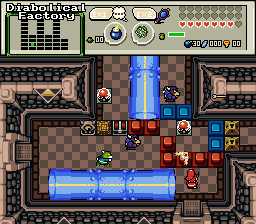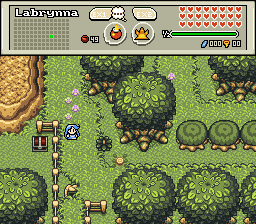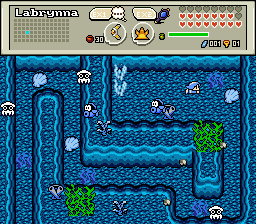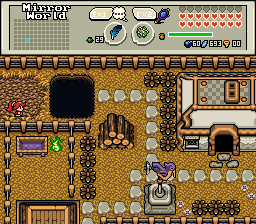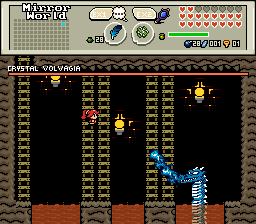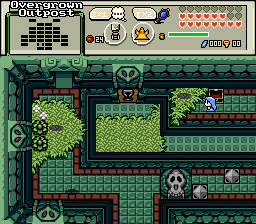Destiny or the Oracles is epic in scope, virtually seamless in refinement, and brings a whole lot of gameplay content to the player. Obviously inspired by the gameboy zelda titles, of which I have to admit I am not that familiar, DotO seems to be a loose interpretation of those official games, both for better and for worse.
To start with, the core gimmick of DotO, mainly that two separate, playable characters must cooperate throughout separate - but linked - worlds, is inherently pretty difficult to pull off. A lot of thought obviously went into the design of the two overworlds and the cave systems, as well as the events triggered by each character, in order to advance the story in the other world. Both overworlds are very well done in my opinion, both in the aesthetic and the practical senses. The various landscapes flow together well and just look pleasing to the eye, with a good amount of detail throughout, but also avoiding the pitfall of over-detailed screen palettes distracting the player. The warp system in both worlds is well implemented and useful.
While playing through, I encountered zero errors with regards to the save/continue system, switching between characters, or event-related strings and scripts. I cannot recall any layering, or other bugs, wherein I became stuck and had to reset. The quest is very well done from a technical standpoint. Even though I cannot even begin to really understand the technical specifics, I can intuit that putting something together like this, and to refine it to such an extent, must be very difficult and time consuming. There are also a wealth of side quests to keep the player busy between various dungeons, and related exploration needed to advance the story, which is always appreciable.
Unfortunately, I just had a hard time staying engaged with the dungeons themselves. If you have played any of the quest maker's other quests, such as Passage Through time, you may be familiar with the dungeon-design philosophy also used in DotO. Mainly, while the dungeons themselves are pretty large and multi-floor, and even multi-phasic at times, I would not call the dungeons particularly complex. I mean, at least not complex for me, the player, to play through. Mainly, there is one necessary strategy used throughout: play through blocks of 5-7 screens at a time to find a key or keys, unlock a door or keyblocks somewhere else, then repeat. There is very little cohesion in the dungeons as a whole, and thus, navigation is incredibly simple and boring at times. While this means that backtracking is also kept to a minimum, which some players really appreciate, there is also often no need to revisit screens or even large swaths of a particular dungeon if you can (and you probably can) intuit the correct path the first time. Another problem I had, particularly in the later dungeons that use a warping system, is that I found it hard to keep track of where I was due to lack of distinctive visual cues. By that I mean, while navigation remained quite simple if I made sure to check carefully with the spacebar map, I had to do a lot of looking at the spacebar map because the screens kind of all blend together and look the same.
A notable exception to my feeling disengaged with the dungeons are the Black Tower and Hall of Mirrors, both of which made me stop and think several times about how to proceed. I would call the Black Tower a bonafide complex dungeon, and one where the core gimmick of two playable characters cooperating really shines. I kind of wish all the dungeons were like this, with playable characters working together on the same screen to solve puzzles, like there is throughout Panoply of Calatia for instance, although that would require a radical redevelopment and would be outside the quest's stated aim. I have to admit, I also liked the Din Level-4 bottomless hole dungeon quite a bit. The earlier dungeons also contain some secrets that can be obtained and triggered by items obtained later, so make note when you see a big treasure chest that you can't access for whatever reason. I think that the puzzles, while often quite simple to solve, were also implemented pretty strategically in such a way to help with good pacing throughout the dungeons.
There are an incredible amount of custom enemies and bosses used throughout DotO. Unfortunately, particularly in the later dungeons, I think the execution of these custom enemies was not the best. For example, the Zelda-2-style enemies, in all of their huge-sprite glory, end up walking all over the screen at times, including ignoring layers and other hypothetical obstacles. Honestly, also particularly in the later levels, there are often just too many enemies per given screen and it becomes a serious chore to try to defeat them all before advancing. My tactic for these later dungeons was full of tanking damage, using the Roc's (I mean the Moosh's) feather with Din, or spamming the Sword of Fate with Nayru just so I didn't have to spend so long dealing with enemies. Likewise, those same tactics seemed to work pretty well when it comes to dealing with bosses. Perhaps because I'm good at exploring and finding health and defensive upgrades, little strategy was required on my part for any bosses besides tanking damage and attacking aggressively. To that end, almost all bosses and mini-bosses went down very easily the first time. Those ones that have a large amount of HP, for which I found tanking damage wasn't that effective due to the length of the fight, also, as it turns out, go down easily if one picks a more effective weapon to attack aggressively with.
With all of the side quests, custom enemies, bosses, and mini-bosses used throughout, DotO really starts to teeter on that "everything but the kitchen sink" level of excess. By that I mean, there are enemies and NPCs from many Zelda games, but also easter eggs, scripted gimmicks, and Zelda-Classic-community inside jokes, that it all starts to seem thrown in "just because" and doesn't really add very much to the gameplay experience in my opinion. If you've played Ballad of a Bloodline, you may understand what I'm talking about where the external fluff seems to steal focus from the core plot and kind of take over in and of itself. I think that this is a pretty minor gripe but certainly worth pointing out.
Overall, before any post-game content, I experienced a good 22-hours of so of gameplay from Destiny of the Oracles. With the post-game content, that time is closer to 27 hours. I want to say that the quest plays a lot like the gameboy Zelda titles, but with ywkls' dungeon-design philosophy and a whole lot of padding also thrown in to bolster the experience. Despite the flaws, it is very evident that an immense amount of time and effort went in to producing the quest and this definitely shows through in a smooth gameplay experience. The overworlds, as well as the two dungeons where multiple playable characters are able to interact, are definitely the big highlight to DotO.
- Current Location:
- PureZC
- » PureZC Forums
- » Quests
- » Destiny of the Oracles
Destiny of the Oracles
Overview
Feature Quest
Creator:
ywkls
Genre: Story-driven
Added: 11 Sep 2020
Updated: 10 Apr 2024
ZC Version: 2.53
Downloads: 2028
Rating[?]:

|
Download Quest (29.37 MB) |
Information
Warning!! - Please play this quest on ZC Version 2.53 or newer! Failure to do so may cause game-breaking bugs.
Quest is bundled with experimental 2.55 build and each version is labelled. Please report bugs if using the newer version.
After Passage Through Time, Link travels to Labrynna to discover what has gone wrong there.
However, things don't go exactly as planned.
Quest is bundled with experimental 2.55 build and each version is labelled. Please report bugs if using the newer version.
After Passage Through Time, Link travels to Labrynna to discover what has gone wrong there.
However, things don't go exactly as planned.
About Reviews Comments Forum Topics
Description
It has been a long, hard road...
But at last, the Hero of Hyrule has reached Labrynna...
Explore 17 complex dungeons!
Solve new puzzles to reach your goal!
Fight 54 unique bosses!
Travel between worlds and obtain new items to discover even more secrets!
Uncover hidden mini-games!
As events unfold, you must take on the powers given to the legendary Oracles; Din and Nayru.
Journey through a Labrynna whose past has been subtly altered, erasing the Hero from time.
Visit a strange Mirror World, where the forces of evil hold sway.
Play as two separate characters with unique strengths and abilities!
Warp between worlds, cooperating to open the path forward!
Uncover strange items, complex ruins, hidden bosses, tricky mini-games... and more!
Continue the path through the 4 Lands paved by those gone before you.
Lead the Oracles onwards... to meet their Destiny.
Future updates will use version 3.0.
This will break saves from earlier versions.
But at last, the Hero of Hyrule has reached Labrynna...
Explore 17 complex dungeons!
Solve new puzzles to reach your goal!
Fight 54 unique bosses!
Travel between worlds and obtain new items to discover even more secrets!
Uncover hidden mini-games!
As events unfold, you must take on the powers given to the legendary Oracles; Din and Nayru.
Journey through a Labrynna whose past has been subtly altered, erasing the Hero from time.
Visit a strange Mirror World, where the forces of evil hold sway.
Play as two separate characters with unique strengths and abilities!
Warp between worlds, cooperating to open the path forward!
Uncover strange items, complex ruins, hidden bosses, tricky mini-games... and more!
Continue the path through the 4 Lands paved by those gone before you.
Lead the Oracles onwards... to meet their Destiny.
Future updates will use version 3.0.
This will break saves from earlier versions.
Update History
Version 1.0
9-19-20- Added a missing warp in the boss rush
9-20-20- Adjusted a script to stop a crash in 2.55
9-21-20- Adjusted all other scripts to avoid same crash
9-22-20
Added trigger in Din level 3 to require the level 2 wand crystal.
Added sign to explain what is needed there.
Adjusted combos across the quest to avoid CSet errors in 2.53 and newer.
Changed activation of fire or ice powers with the Magic Book.
Now used a left-click since some people apparently don't have a center wheel on the mouse.
Adjusted text on item acquisition to reflect this.
Removed Ice Wizzrobes from a room in Din level 5 where you could use them to damage boost past the fans and softlock.
9-24-20- Fixed tile error in Nayru level 5
9-25-20
Fixed combo error where you could walk behind a tree and get stuck
Fixed an error in a script setting in a post-game dungeon which could cause a softlock
9-29-20
Changed subscreen for the Black Tower so it shows you can use the Magical Mirror
Fixed some layer errors
Fixed some walkability errors
10-1-20- Adjusted scripted enemies so they don't jump/fly through Z-Axis
10-11-20
Changed script for base level wand so it can slash and drop items
Made various graphical adjustments
10-13-20- Adjusted some rooms with pits to remove bugs.
10-14-20
Fixed an issue with the letter delivery sidequest
Fixed an issue with Hamiltonian Path script
Fixed an issue with the Mole Mitts
Fixed a bug with the Revival Potion script
10-15-20- Reworked the game over script to deal with bugs
10-23-20
Added flowing water indicator in Nayru level 7
Fixed a combo error
10-25-20
Adjusted a cutscene
Adjusted script handling items to remove a rare bug
Changed how the "hot room" effect works in the post-game
11-19-20
Added npc in hut to explain lighting fire with book
Changed torch near Din level 6 to react to magic like similar switches
Updated script for drawing Nayru to eliminate a bug while underwater
11-21-20- Fixed combo errors in Nayru level 7.
12-7-20
Added a sign in Din level 7, explaining the orange warps.
Adjusted hamiltonian path script to remove a minor bug.
Adjusted room in DIn level 7 where you have to climb a waterfall blindly to make it easier.
Adjusted script for the Masked Rito to keep it from getting stuck in the wall.
Adjusted script for the Revival Potion to fix an error.
Fixed some combo errors.
12-11-20
Added sign in Din level 8, explaining how to change seasons.
Fixed bug where some enemies could be harmed by their own dash attacks.
Updated large blue and orange treasure chest setup throughout the quest.
12-15-20
Changed puzzle in Nayru level 2 that requires Magic Book to a "put out the fire" trigger
Fixed a bug where using Quake in sideview could result in a softlock
Fixed defense settings on 2 bosses which were incorrectly vulnerable to Quake
12-17-20
Changed appearance of frozen treasure chests in Din level 5 when you've opened the corresponding chest on the other floor
Fixed clue to Farore mini-game that was incorrect
Fixed a script error which could allow you to use items in certain menus
12-18-20- Changed a Farore mini-game
12-25-20
Added clue about using Ice on Blue Fire
Changed Magic Book trigger in Lynna City to match Labrynnan Library
Fixed a warp error in a Farore mini-game
Fixed a typo
Fixed an enemy placement error
Fixed combo error in Nayru level 8
Fixed ffc carryover issues with Whistle Spots in Nayru level 8
12-29-20
Fixed combo error in Nayru level 8
Fixed ffc carryover issues with Whistle Spots in Nayru level 8
Fixed string error in letter delivery
Fixed error with Magic Mirror script
12-31-20
Added a clue about freezing water in the Black Tower
Fixed a string error in a letter delivery
Fixed a tile error in the Black Tower
Fixed an ffc carryover issue that could cause a softlock
1-2-21- Fixed an issue in the 3rd secret dungeon that could cause a softlock
9-19-20- Added a missing warp in the boss rush
9-20-20- Adjusted a script to stop a crash in 2.55
9-21-20- Adjusted all other scripts to avoid same crash
9-22-20
Added trigger in Din level 3 to require the level 2 wand crystal.
Added sign to explain what is needed there.
Adjusted combos across the quest to avoid CSet errors in 2.53 and newer.
Changed activation of fire or ice powers with the Magic Book.
Now used a left-click since some people apparently don't have a center wheel on the mouse.
Adjusted text on item acquisition to reflect this.
Removed Ice Wizzrobes from a room in Din level 5 where you could use them to damage boost past the fans and softlock.
9-24-20- Fixed tile error in Nayru level 5
9-25-20
Fixed combo error where you could walk behind a tree and get stuck
Fixed an error in a script setting in a post-game dungeon which could cause a softlock
9-29-20
Changed subscreen for the Black Tower so it shows you can use the Magical Mirror
Fixed some layer errors
Fixed some walkability errors
10-1-20- Adjusted scripted enemies so they don't jump/fly through Z-Axis
10-11-20
Changed script for base level wand so it can slash and drop items
Made various graphical adjustments
10-13-20- Adjusted some rooms with pits to remove bugs.
10-14-20
Fixed an issue with the letter delivery sidequest
Fixed an issue with Hamiltonian Path script
Fixed an issue with the Mole Mitts
Fixed a bug with the Revival Potion script
10-15-20- Reworked the game over script to deal with bugs
10-23-20
Added flowing water indicator in Nayru level 7
Fixed a combo error
10-25-20
Adjusted a cutscene
Adjusted script handling items to remove a rare bug
Changed how the "hot room" effect works in the post-game
11-19-20
Added npc in hut to explain lighting fire with book
Changed torch near Din level 6 to react to magic like similar switches
Updated script for drawing Nayru to eliminate a bug while underwater
11-21-20- Fixed combo errors in Nayru level 7.
12-7-20
Added a sign in Din level 7, explaining the orange warps.
Adjusted hamiltonian path script to remove a minor bug.
Adjusted room in DIn level 7 where you have to climb a waterfall blindly to make it easier.
Adjusted script for the Masked Rito to keep it from getting stuck in the wall.
Adjusted script for the Revival Potion to fix an error.
Fixed some combo errors.
12-11-20
Added sign in Din level 8, explaining how to change seasons.
Fixed bug where some enemies could be harmed by their own dash attacks.
Updated large blue and orange treasure chest setup throughout the quest.
12-15-20
Changed puzzle in Nayru level 2 that requires Magic Book to a "put out the fire" trigger
Fixed a bug where using Quake in sideview could result in a softlock
Fixed defense settings on 2 bosses which were incorrectly vulnerable to Quake
12-17-20
Changed appearance of frozen treasure chests in Din level 5 when you've opened the corresponding chest on the other floor
Fixed clue to Farore mini-game that was incorrect
Fixed a script error which could allow you to use items in certain menus
12-18-20- Changed a Farore mini-game
12-25-20
Added clue about using Ice on Blue Fire
Changed Magic Book trigger in Lynna City to match Labrynnan Library
Fixed a warp error in a Farore mini-game
Fixed a typo
Fixed an enemy placement error
Fixed combo error in Nayru level 8
Fixed ffc carryover issues with Whistle Spots in Nayru level 8
12-29-20
Fixed combo error in Nayru level 8
Fixed ffc carryover issues with Whistle Spots in Nayru level 8
Fixed string error in letter delivery
Fixed error with Magic Mirror script
12-31-20
Added a clue about freezing water in the Black Tower
Fixed a string error in a letter delivery
Fixed a tile error in the Black Tower
Fixed an ffc carryover issue that could cause a softlock
1-2-21- Fixed an issue in the 3rd secret dungeon that could cause a softlock
Version 2.0
3-11-21
Added support for sideview water warping you back to the previous screen if you jump into it from offscreen
Now you appear at the last solid point (or sideview ladder) you were standing on when you fell in the water
Fixed issue where fast Armos might look like Peahats
Fixed possible conflict between bracelet and other scripts
Updated and recompiled scripts for 2.53
3-20-21
Added script to drop ammo refills in Masked Bow Wow fight
Adjusted examinable objects to not work while subscreen is open.
Removed a character from the true ending
5-2-21
Added an automatic initial save point for Nayru right after the introductory cutscenes
Fixed flag placement error
Slightly altered second cutscene between Marin and Farore
5-20-21- Fixed bug caused by initial save point for Nayru
5-23-21- Added script to make slashing pots make sounds
5-24-21
Fixed various warp errors
Fixed ffc error with Farore mini-game
5-25-21- Added script to make boss music only play while enemy is alive.
7-4-21
Added no enemy flags to some water in Nayru level 1
Changed dialogue for guy in Mirror World clue house
Changed dialogue for guy in Labrynna post office
Fixed DMap name error
Fixed combo error
Fixed bug with Boss Music script
Fixed error with Fake Mirror
Fixed error with save point script
7-5-21
Changed appearance of mailbox indicator for Masked Marauders
Fixed bug with pits that could send you out of bounds
Fixed bug with drawing Summer Heat weapon
Fixed bug with Crystal Altar script
7-11-21
Added fake mailbox on Crescent Isle
Fixed bug with level 2 arrow fire being flipped incorrectly
Fixed more bugged pits that could sense you out of bounds
Fixed error with mailboxes north of Lynna City and west of Graveyard
7-25-21
Added one-way shutter to Crystal Volvagia fight
Added shortcut to Nayru level 6 opening
Adjusted level 2 arrow trigger in Nayru level 5 to be consistent with others
Adjusted HP restored by Farore's healing ability in the last dungeon
Changed appearance of Din level 7 entrance so it doesn't look like a bombable wall
Changed a useless room in Din level 5 so it's required
Changed trigger for Nayru level 7 to Ether
Fixed color error with Agahnim sprite
Fixed bug with Cane of Somaria puzzle
Fixed walkability error outside Nayru level 6
Fixed major bug with scripted water
Updated Marin sprite
8-9-21
Added an ffc for flowing air where one was missing
Adjusted a few screens in Din level 7
Fixed layer error in Din level 6
Fixed combo error
Fixed a major bug with sideview swimming that would softlock you where the quest couldn't be finished
Updated sideview swimming to be more responsive
Updated quest description to require 2.53 or newer
8-15-21
Adjusted Crystalline Flame markers outside Veran's Castle
Adjusted lava in Volcanic Crater
Changed lava in Din's secret dungeon to water
Fixed pits in level 9
Fixed CSet error in cutscene
Fixed a significant bug with the super-boss
Fixed bug with Cane of Somaria script
Fixed sideview water in secret final dungeon
Fixed ffc error
8-31-21
Added sign outside entrance to level 6 reminding how to light torch
Changed trigger to open Nayru level 7 back to lightning rod
Updated lava script
9-1-21- Updated sideview water script
9-2-21- Fixed bug in Farore dungeon
9-3-21
Fixed hole/path puzzle in Nayru level 7
Fixed another bug with sideview water
9-25-21- Updated ffc launcher script to fix bug which limited how often it could be used
12-4-21- Fixed two midis. Thanks to SCKnuckles for these adjustments.
1-23-22
Added a carryover secret
Adjusted a layer
Adjusted amount healed by fairies to 50%
Fixed some secret errors
Fixed cset errors
Fixed a potential softlock involving Like Likes
7-22-22
Adjusted some barriers in The Black Tower
Fixed an issue which caused the Harp of Ages to stop working
10-23-22
Added clue to bombable wall in Din level 2
Added message explaining that healing potions get stronger as you go
Added npc near first blue chest with clue about progressive items in blue chests.
Added check for level 2 armor upgrade by level 3 armor upgrade
Added clue about needing this to get the item
Added barrier near the bottom of Din level 4 to keep you from leaving by accident before hitting a switch
Adjusted a room in Din level 3
Adjusted string after Din level 4
Changed blue chests for armor upgrades to be progressive
Changed how sideview water works completely
Changed a room in post-game dungeon accordingly
Fixed typos
Fixed bug with locked doors in Din level 4
11-19-22
Added think combo to npc script to show you can interact
Adjusted puzzle in Nayru's level 7
Adjusted pits in Nayru's level 8
Adjusted a layer
Adjusted puzzle in Nayru's level 8
Fixed bug with level 9 where partner didn't appear when crossing over worlds
Fixed bug with map script
Fixed bug with switchhook diamonds in level 9
1-28-21
Added clues to reach the true final dungeon
Added fences in the Volcanic Crater
Adjusted Tunkrad defenses to have more weaknesses
Adjusted fences near the Mirror World farm
Changed Hot Room effects back to global
Changed level 2 Ropes to no longer be flashing
Fixed a CSet error
Fixed a secret combo error
Fixed some warp errors
Fixed various ffc errors
Fixed a flag error
Fixed string error
Fixed some combo errors
Fixed error where Nayru's Love could glitch if projectiles were in midair
Fixed bug with secret final boss
Fixed error with warp out of final dungeon
Fixed bug with tango menus where you could use items while in the menu
Updated scripts for Crystal Altars and clues to function correctly
Revised Hole-Lava script to correctly interact when you jump in one from offscreen
Added clues to reach the true final dungeon
Added fences in the Volcanic Crater
Adjusted Tunkrad defenses to have more weaknesses
Adjusted fences near the Mirror World farm
Changed Hot Room effects back to global
Changed level 2 Ropes to no longer be flashing
Fixed a CSet error
Fixed a secret combo error
Fixed some warp errors
Fixed various ffc errors
Fixed a flag error
Fixed string error
Fixed some combo errors
Fixed error where Nayru's Love could glitch if projectiles were in midair
Fixed bug with secret final boss
Fixed error with warp out of final dungeon
Fixed bug with tango menus where you could use items while in the menu
Updated scripts for Crystal Altars and clues to function correctly
Revised Hole-Lava script to correctly interact when you jump in one from offscreen
3-11-21
Added support for sideview water warping you back to the previous screen if you jump into it from offscreen
Now you appear at the last solid point (or sideview ladder) you were standing on when you fell in the water
Fixed issue where fast Armos might look like Peahats
Fixed possible conflict between bracelet and other scripts
Updated and recompiled scripts for 2.53
3-20-21
Added script to drop ammo refills in Masked Bow Wow fight
Adjusted examinable objects to not work while subscreen is open.
Removed a character from the true ending
5-2-21
Added an automatic initial save point for Nayru right after the introductory cutscenes
Fixed flag placement error
Slightly altered second cutscene between Marin and Farore
5-20-21- Fixed bug caused by initial save point for Nayru
5-23-21- Added script to make slashing pots make sounds
5-24-21
Fixed various warp errors
Fixed ffc error with Farore mini-game
5-25-21- Added script to make boss music only play while enemy is alive.
7-4-21
Added no enemy flags to some water in Nayru level 1
Changed dialogue for guy in Mirror World clue house
Changed dialogue for guy in Labrynna post office
Fixed DMap name error
Fixed combo error
Fixed bug with Boss Music script
Fixed error with Fake Mirror
Fixed error with save point script
7-5-21
Changed appearance of mailbox indicator for Masked Marauders
Fixed bug with pits that could send you out of bounds
Fixed bug with drawing Summer Heat weapon
Fixed bug with Crystal Altar script
7-11-21
Added fake mailbox on Crescent Isle
Fixed bug with level 2 arrow fire being flipped incorrectly
Fixed more bugged pits that could sense you out of bounds
Fixed error with mailboxes north of Lynna City and west of Graveyard
7-25-21
Added one-way shutter to Crystal Volvagia fight
Added shortcut to Nayru level 6 opening
Adjusted level 2 arrow trigger in Nayru level 5 to be consistent with others
Adjusted HP restored by Farore's healing ability in the last dungeon
Changed appearance of Din level 7 entrance so it doesn't look like a bombable wall
Changed a useless room in Din level 5 so it's required
Changed trigger for Nayru level 7 to Ether
Fixed color error with Agahnim sprite
Fixed bug with Cane of Somaria puzzle
Fixed walkability error outside Nayru level 6
Fixed major bug with scripted water
Updated Marin sprite
8-9-21
Added an ffc for flowing air where one was missing
Adjusted a few screens in Din level 7
Fixed layer error in Din level 6
Fixed combo error
Fixed a major bug with sideview swimming that would softlock you where the quest couldn't be finished
Updated sideview swimming to be more responsive
Updated quest description to require 2.53 or newer
8-15-21
Adjusted Crystalline Flame markers outside Veran's Castle
Adjusted lava in Volcanic Crater
Changed lava in Din's secret dungeon to water
Fixed pits in level 9
Fixed CSet error in cutscene
Fixed a significant bug with the super-boss
Fixed bug with Cane of Somaria script
Fixed sideview water in secret final dungeon
Fixed ffc error
8-31-21
Added sign outside entrance to level 6 reminding how to light torch
Changed trigger to open Nayru level 7 back to lightning rod
Updated lava script
9-1-21- Updated sideview water script
9-2-21- Fixed bug in Farore dungeon
9-3-21
Fixed hole/path puzzle in Nayru level 7
Fixed another bug with sideview water
9-25-21- Updated ffc launcher script to fix bug which limited how often it could be used
12-4-21- Fixed two midis. Thanks to SCKnuckles for these adjustments.
1-23-22
Added a carryover secret
Adjusted a layer
Adjusted amount healed by fairies to 50%
Fixed some secret errors
Fixed cset errors
Fixed a potential softlock involving Like Likes
3-11-22
Added text explaining how to open large blue chests
Added a secret to make part of Din's level 4 easier.
Added barriers in Din level 1 and secret level to prevent accidental game overs
Added refill statue in Frigid Fields
Added refill statue near Nayru level 6
Added sideview ladders in all areas with sideview water
Added clue on how to damage Carock in level 9
Added barrier in crater to prevent going offscreen
Adjusted area outside Nayru level 4 to prevent a softlock.
Adjusted sideview water scripts
Adjusted a screen in Din level 7
Adjusted some rooms in Nayru level 5 to prevent a scenario which excluded the large blue chest
Fixed string errors
Fixed CSet errors
Fixed layer errors
Fixed bug with Water Robes
Fixed bug where you can drown in lava while using Fall Breeze
Fixed bug with firebars
Fixed bug with fairy follower script
Fixed bugs with holes in Nayru level 7, 8 and Labrynna overworld.
Fixed solidity error
Fixed warp error
Fixed some bugs with Cane of Somaria
Fixed bug with secret final boss fight
Moved a spot to switch boot powers in Din level 7
Removed shutter from Crystal Volvagia fight
Added text explaining how to open large blue chests
Added a secret to make part of Din's level 4 easier.
Added barriers in Din level 1 and secret level to prevent accidental game overs
Added refill statue in Frigid Fields
Added refill statue near Nayru level 6
Added sideview ladders in all areas with sideview water
Added clue on how to damage Carock in level 9
Added barrier in crater to prevent going offscreen
Adjusted area outside Nayru level 4 to prevent a softlock.
Adjusted sideview water scripts
Adjusted a screen in Din level 7
Adjusted some rooms in Nayru level 5 to prevent a scenario which excluded the large blue chest
Fixed string errors
Fixed CSet errors
Fixed layer errors
Fixed bug with Water Robes
Fixed bug where you can drown in lava while using Fall Breeze
Fixed bug with firebars
Fixed bug with fairy follower script
Fixed bugs with holes in Nayru level 7, 8 and Labrynna overworld.
Fixed solidity error
Fixed warp error
Fixed some bugs with Cane of Somaria
Fixed bug with secret final boss fight
Moved a spot to switch boot powers in Din level 7
Removed shutter from Crystal Volvagia fight
7-22-22
Adjusted some barriers in The Black Tower
Fixed an issue which caused the Harp of Ages to stop working
10-23-22
Added clue to bombable wall in Din level 2
Added message explaining that healing potions get stronger as you go
Added npc near first blue chest with clue about progressive items in blue chests.
Added check for level 2 armor upgrade by level 3 armor upgrade
Added clue about needing this to get the item
Added barrier near the bottom of Din level 4 to keep you from leaving by accident before hitting a switch
Adjusted a room in Din level 3
Adjusted string after Din level 4
Changed blue chests for armor upgrades to be progressive
Changed how sideview water works completely
Changed a room in post-game dungeon accordingly
Fixed typos
Fixed bug with locked doors in Din level 4
11-19-22
Added think combo to npc script to show you can interact
Adjusted puzzle in Nayru's level 7
Adjusted pits in Nayru's level 8
Adjusted a layer
Adjusted puzzle in Nayru's level 8
Fixed bug with level 9 where partner didn't appear when crossing over worlds
Fixed bug with map script
Fixed bug with switchhook diamonds in level 9
Version 3.0
4-6-24 Fixed Farore minigame
4-10-24
Adjusted room in Farore dungeon
Adjusted room in Hall of Mirrors
Fixed secret errors
Fixed flag error
Fixed walkability errors
Fixed Farore minigame rematch
4-1-24
Updated quest file to ZC Version 2.55
Added zip file using both 2.53 and 2.55 versions
Adjusted room in secret final dungeon
Adjusted room in Nayru level 7
Adjusted room in Nayru level 6
Added new lifting animation
Added new pots, pits, item strings, signs and most npcs
Added new darkness effect to Nayru's trial dungeon
Added Epona galloping sound to barn and minigame area
Added sound effects to most stairs
Fixed ffc bugs
Updated mechanics for ice block puzzles
Updated flowing air mechanics
Updated lava mechanics
Updated all pits
Updated all water to include unsafe ground tags to prevent permanent drowning
Updated true ending to reflect sequel plans
Updated quest file to ZC Version 2.55
Added zip file using both 2.53 and 2.55 versions
Adjusted room in secret final dungeon
Adjusted room in Nayru level 7
Adjusted room in Nayru level 6
Added new lifting animation
Added new pots, pits, item strings, signs and most npcs
Added new darkness effect to Nayru's trial dungeon
Added Epona galloping sound to barn and minigame area
Added sound effects to most stairs
Fixed ffc bugs
Updated mechanics for ice block puzzles
Updated flowing air mechanics
Updated lava mechanics
Updated all pits
Updated all water to include unsafe ground tags to prevent permanent drowning
Updated true ending to reflect sequel plans
4-5-24
Added pit warps to entrance to Din level 3
Added functional lava
Added pit edge corners
Adjusted rooms in Nayru level 7 and the Black Tower
Fixed secret errors
Fixed sound effect error
Fixed room errors
Fixed layer error
Fixed pit animation
Fixed falling from ceiling effect
Removed extra signpost
Added pit warps to entrance to Din level 3
Added functional lava
Added pit edge corners
Adjusted rooms in Nayru level 7 and the Black Tower
Fixed secret errors
Fixed sound effect error
Fixed room errors
Fixed layer error
Fixed pit animation
Fixed falling from ceiling effect
Removed extra signpost
4-6-24 Fixed Farore minigame
4-10-24
Adjusted room in Farore dungeon
Adjusted room in Hall of Mirrors
Fixed secret errors
Fixed flag error
Fixed walkability errors
Fixed Farore minigame rematch
Story
Immediately after the events of Passage Through Time, Link travels to Labrynna. There he finds that events in the present have been altered somehow.
Before Link can intervene, a terrible darkness captures him and the disturbance caused awakens the power of the ancient goddesses who once brought Hyrule into existence.
Calling upon the service of Din, the Oracle of Seasons and Nayru; the Oracle of Ages- they are given powerful items with which they can help to free the Hero and those like him pressed into the service of evil.
Journey with Din as she struggles to survive in the Mirror World where Veran originated.
Guide Nayru as she attempts to unravel the secrets of a Labrynna she scarcely recognizes.
Together, they must discover ways to correct the changes in Labrynna and unite the powers of the two worlds against the forces which have arisen.
Only then, will they at last learn their true destiny...
Play as 2 separate characters in parallel worlds with different abilities!
Find the hidden secrets to help the inhabitants of the land to solve their problems!
Recover the Essences of Time and the Fragments of Darkness to pave the way towards a better tomorrow!
Only you can change the fate that awaits the Oracles and all they hold dear...
Before Link can intervene, a terrible darkness captures him and the disturbance caused awakens the power of the ancient goddesses who once brought Hyrule into existence.
Calling upon the service of Din, the Oracle of Seasons and Nayru; the Oracle of Ages- they are given powerful items with which they can help to free the Hero and those like him pressed into the service of evil.
Journey with Din as she struggles to survive in the Mirror World where Veran originated.
Guide Nayru as she attempts to unravel the secrets of a Labrynna she scarcely recognizes.
Together, they must discover ways to correct the changes in Labrynna and unite the powers of the two worlds against the forces which have arisen.
Only then, will they at last learn their true destiny...
Play as 2 separate characters in parallel worlds with different abilities!
Find the hidden secrets to help the inhabitants of the land to solve their problems!
Recover the Essences of Time and the Fragments of Darkness to pave the way towards a better tomorrow!
Only you can change the fate that awaits the Oracles and all they hold dear...
Tips & Cheats
Visual Sensitivity Advisory: This quest includes numerous instances of flashing lights. There are also effects such as wavy or distortion layers in many places. If you have any issues with these things, please consider this when playing the quest.
Each character must obtain a specific item before they can enter their first dungeon.
After getting the Magical Mirror, you can use special Sheikah Statues to travel between worlds.
Once each pair of dungeons is finished, you can proceed to the next dungeon for either character.
Individuals who give clues to where to go for this exist in either world.
Additionally, it is possible to purchase a very expensive item which provides clues to the locations of sidequest events,
Completing all sidequests in both world gives access to post-game content.
This includes 1 exclusive dungeon for Din and Nayru along with a secret final dungeon.
Each character must obtain a specific item before they can enter their first dungeon.
After getting the Magical Mirror, you can use special Sheikah Statues to travel between worlds.
Once each pair of dungeons is finished, you can proceed to the next dungeon for either character.
Individuals who give clues to where to go for this exist in either world.
Additionally, it is possible to purchase a very expensive item which provides clues to the locations of sidequest events,
Completing all sidequests in both world gives access to post-game content.
This includes 1 exclusive dungeon for Din and Nayru along with a secret final dungeon.
Credits
Tileset- DoR (Hybrid)
Testers- Epsalon ZX, Eppy, judasrising, Ryunaker, Zolias, Moosh
Minor Testers- Spacepoet, deme, Masterlink, Shoshon the Elegant, Dimentio, LordKronos, Gendof, Jared
Script Assists- Moosh, Venrob, Lejes, ZoriaRPG, Russ, Aevin, Dimentio
Borrowed Scripts- Mero, Saffith, Moosh, Lejes, Joe123,
justin, MoscowModder, Collosal, ZoriaRPG, Russ
Primary Music Advisor- SCKnuckles
Sprite Contributor- P-Tux7
Script Inspiration- Mitsukara, Zaxarone, Lüt, Pastille of Rohan,
Binx, SCKnuckles, Alucard648, Dimentio, Moosh, Russ
Music- PureZC Artists, VGMusic
Sound Effects- HelptheWretched
Other Contrubutors- Binx, Xenomicx
Imported Tiles by-
Anthus, Pepeztyle, Yue, Moon, ChaosMiles07,
Epona4, Silverbolt, Lord Zymeth, JoshR_691,
Master Link, KeatonGirl13, Rakia, Gussprint,
Nemu, Vaati, Shred Mako, Bacon, Shadow Kami,
Sonikku, Spriter Trooper, bucketboy, Darth RPG,
Blueyosh, Davias, Dazz, Bruce Juice, Explosion makes BOOM!!
Rocksfan13, CrimsonPenguin, Other Spriters Resource Artists
Special Thanks:
Luspeon- For inadvertently breaking me out of my slump
and spinning this quest in an entirely different direction.
Epsalon ZX- For regularly testing and making suggestions to improve the overall quality of the quest.
SCKnuckles- For agreeing to help select the music for this quest, which I always find hard
Also for looping a good deal of the soundtrack correctly.
P-Tux7- For creating a lot of sprites for the project without being asked and making
suggestions on the development of the quest
Eppy- For testing the quest not once, or twice but at least 4 times
and making me increase enemy variety
ZScript Group- For teaching me more about how this process worked than I ever knew was possible.
PureZC Community- For waiting ? years for me to finally get around to finishing this.
Nintendo- For making the Legend of Zelda series.
Testers- Epsalon ZX, Eppy, judasrising, Ryunaker, Zolias, Moosh
Minor Testers- Spacepoet, deme, Masterlink, Shoshon the Elegant, Dimentio, LordKronos, Gendof, Jared
Script Assists- Moosh, Venrob, Lejes, ZoriaRPG, Russ, Aevin, Dimentio
Borrowed Scripts- Mero, Saffith, Moosh, Lejes, Joe123,
justin, MoscowModder, Collosal, ZoriaRPG, Russ
Primary Music Advisor- SCKnuckles
Sprite Contributor- P-Tux7
Script Inspiration- Mitsukara, Zaxarone, Lüt, Pastille of Rohan,
Binx, SCKnuckles, Alucard648, Dimentio, Moosh, Russ
Music- PureZC Artists, VGMusic
Sound Effects- HelptheWretched
Other Contrubutors- Binx, Xenomicx
Imported Tiles by-
Anthus, Pepeztyle, Yue, Moon, ChaosMiles07,
Epona4, Silverbolt, Lord Zymeth, JoshR_691,
Master Link, KeatonGirl13, Rakia, Gussprint,
Nemu, Vaati, Shred Mako, Bacon, Shadow Kami,
Sonikku, Spriter Trooper, bucketboy, Darth RPG,
Blueyosh, Davias, Dazz, Bruce Juice, Explosion makes BOOM!!
Rocksfan13, CrimsonPenguin, Other Spriters Resource Artists
Special Thanks:
Luspeon- For inadvertently breaking me out of my slump
and spinning this quest in an entirely different direction.
Epsalon ZX- For regularly testing and making suggestions to improve the overall quality of the quest.
SCKnuckles- For agreeing to help select the music for this quest, which I always find hard
Also for looping a good deal of the soundtrack correctly.
P-Tux7- For creating a lot of sprites for the project without being asked and making
suggestions on the development of the quest
Eppy- For testing the quest not once, or twice but at least 4 times
and making me increase enemy variety
ZScript Group- For teaching me more about how this process worked than I ever knew was possible.
PureZC Community- For waiting ? years for me to finally get around to finishing this.
Nintendo- For making the Legend of Zelda series.
Destiny of the Oracles- Help/Bug TopicStarted by ywkls , 11 Sep 2020 |
|

|
||
Destiny of the Oracles LP- By Melee WizardStarted by ywkls , 15 Sep 2022 |
|

|
||
Destiny of the Oracles LP- By SCKnucklesStarted by ywkls , 24 Sep 2020 |
|
|
||
Destiny of the Oracles LP- By Pen AdelieStarted by ywkls , 18 Jan 2022 |
|

|


